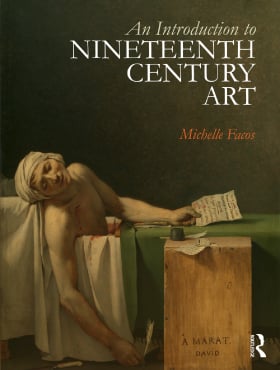Reviews
“This fresh survey of nineteenth century art provides a welcome new perspective. Redressing a long overdue imbalance, artistic developments in America, Britain, Eastern Europe, Germany and Scandinavia are set beside the familiar story of French art, enriching our understanding of the historical context. The many insights and discoveries in this text make it useful to anyone interested in this fundamental era of modern art.”
Jeffery Howe, Boston College, USA
***
“European and American art of the nineteenth century cannot be understood apart from the social and cultural conditions of the day. Michelle Facos recognizes this, explaining the significance of the visual arts of this tumultuous century in relation to such historical forces as the Industrial Revolution, urbanization, the nascent women’s movement, nationalism, imperialism, and colonization. Facos’s rich contextualization of artistic production is supported by judiciously chosen excerpts from primary sources along with useful graphs and sidebar explanations of various techniques. Arts institutions, too, receive particular attention, with helpful discussions of various academies, artists’ organizations, and exhibition venues. Even with this attention to historical context, Facos never takes her eyes off the real focus of the book: the painting, sculpture, and graphic arts produced in Europe and North America between the 1750 and 1900. Her close analyses of individual artworks note the persistence of long-standing aesthetic traditions while also illuminating the relevance of artistic innovation. Well-chosen color reproductions accompany these analyses.
Especially noteworthy is Facos’s insistence that the designation “nineteenth-century art” encompasses more than French and British works with the occasional nod to American contributions. Her account also integrates informative discussions of the visual arts of Russia, Belgium, Italy, Denmark, Sweden, Poland, Serbia, and Hungary as well as the art of the German states. For instance, to well-known artists’ colonies in Brittany, Facos familiarizes readers with the important sites of Worpswede and Skagen.
Written in clear, jargon-free prose, An Introduction to Nineteenth-Century Art offers students an accessible yet lively account of the visual arts in Europe and North America during this century. “
Elizabeth Mansfield, New York University, USA
***
“This is an engaging and stimulating analysis of art in the ‘long nineteenth-century’. Beginning its narrative in the later eighteenth-century, the book offers a view of art which is clear and consistent but never simplistic or reductive. Michelle Facos manages a neat trick of being simultaneously nuanced and subtle, yet also direct and transparent. Thus, in discussing one of the central themes of mid-nineteenth century painting, the imagery of rural labourers, the ambiguity found across the range of works dealing with the subject is fully acknowledged. The images of workers are allowed to be both heroic and threatening, and their contemporary meaning both reassuring and concurrently confusing. They are shown to be represented in techniques both academically conservative and radically innovative. The complex variety of ways in which an image can relate to its contemporary world, through subject, technique, embedded narrative, genre, fashion and more are all discussed in a relaxed and confident manner which never allows the complexity to become confusion.
The author returns to her central theme of exploring the richness and diversity of nineteenth-century art regularly throughout the text and anchors the range of works and ideas discussed in a narrative which insists on the particularity of an artist’s experience as central to true understanding of the work he/she produced. That insistence on context comes across clearly in the use of discrete excerpts of original sources strategically cited throughout the main text. Thus Rousseau is conjoined with Courbet, Burke with Stubbs, Marx with Daumier. Even more regularly occurring are invitations to further explore the works discussed via a variety of resources collected together on a website hosted by the publisher, and devoted to introducing readers to a larger range of material than is possible in a published volume. Interested readers can access maps which will locate all sites mentioned in the text, or can delve more deeply into an individual artist’s sources, or a work’s critical reception, or a variety of modern analyses of a particular image. All this offers added value but it only succeeds because Facos’ analysis is intellectually sound, refreshingly direct and engagingly readable. I enjoyed this book."
John Morrison, University of Aberdeen, UK
***
“This is an excellent textbook for students of nineteenth-century art. Facos's synthesis ranges widely across the countries and genres of nineteenth-century Europe. The emphasis on Paris, characteristic of many other such textbooks, is modified by broadening horizons to include developments in Germany, Britain, Scandinavia, Italy and central Europe. The traditional modernist narrative is displaced by an open-textured historical approach in which the diversity of art production is brought to life in its own context and understood on its own terms. The book is cogent in its broad outlines while also offering compelling readings of individual case-studies that will awaken the interest and curiosity of students. An impressive achievement.”
Dr Nina Lübbren, Anglia Ruskin University, Cambridge, UK
***
“Finally, an updated delightfully usable survey of 19th century art is available. The text is clearly written, jargon-free yet conceptually informed, and well organized. Facos expands areas that are sparsely covered in other surveys, for example, history of photography, women in art, and landscape as a genre. The boxes with primary sources and the easy access online extension of the text are ideal tools to explore complex issues and elegantly facilitate open-ended classroom discussion.”
Lucy Bowditch, The College of Saint Rose, Albany, USA

 Buy the Book
Buy the Book